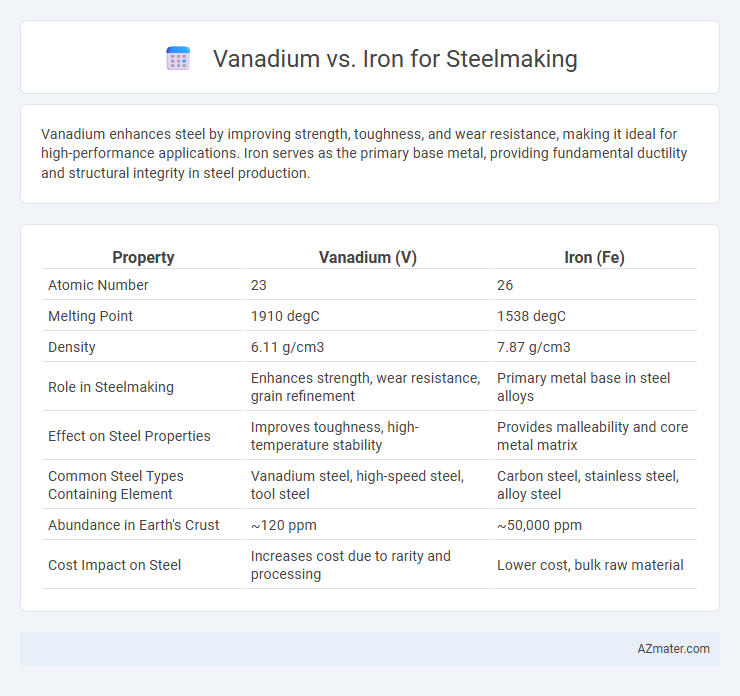Vanadium enhances steel by improving strength, toughness, and wear resistance, making it ideal for high-performance applications. Iron serves as the primary base metal, providing fundamental ductility and structural integrity in steel production.
Table of Comparison
| Property | Vanadium (V) | Iron (Fe) |
|---|---|---|
| Atomic Number | 23 | 26 |
| Melting Point | 1910 degC | 1538 degC |
| Density | 6.11 g/cm3 | 7.87 g/cm3 |
| Role in Steelmaking | Enhances strength, wear resistance, grain refinement | Primary metal base in steel alloys |
| Effect on Steel Properties | Improves toughness, high-temperature stability | Provides malleability and core metal matrix |
| Common Steel Types Containing Element | Vanadium steel, high-speed steel, tool steel | Carbon steel, stainless steel, alloy steel |
| Abundance in Earth's Crust | ~120 ppm | ~50,000 ppm |
| Cost Impact on Steel | Increases cost due to rarity and processing | Lower cost, bulk raw material |
Introduction: Vanadium and Iron in Steelmaking
Vanadium and iron are key elements in steelmaking, with iron serving as the primary metal and vanadium acting as a crucial alloying addition to enhance steel properties. Iron provides the fundamental structure and strength, while vanadium improves hardness, wear resistance, and high-temperature stability. The combination of vanadium and iron in steel production results in advanced materials used in construction, automotive, and aerospace industries.
Chemical Properties: Vanadium vs Iron
Vanadium exhibits a higher melting point (1910degC) compared to iron (1538degC), contributing to enhanced heat resistance in steel alloys. Chemically, vanadium forms stable carbides and nitrides that significantly improve steel hardness and wear resistance, while iron primarily provides the base matrix essential for steel's structural integrity. The distinct oxidation states of vanadium (+2, +3, +4, +5) allow for complex alloy formation, enhancing corrosion resistance and mechanical strength beyond that of pure iron.
Historical Use of Vanadium and Iron in Steel Production
Vanadium has been used since the early 20th century to enhance steel alloys due to its ability to improve strength, toughness, and wear resistance, with significant adoption in tool steels and automotive components. Iron, the primary element in steel production, has a history spanning thousands of years, forming the foundational metal for various steelmaking processes from ancient bloomery methods to modern Bessemer and basic oxygen furnaces. The historical use of vanadium developed as a strategic alloying element to address limitations in pure iron and carbon steels, revolutionizing high-performance steel grades.
Effects on Steel Microstructure
Vanadium significantly refines steel microstructure by promoting the formation of fine vanadium carbides and nitrides, which enhance grain refinement and increase toughness. In contrast, iron, as the base metal, provides the primary matrix but lacks the microstructural strengthening effects that vanadium imparts. Incorporating vanadium in steelmaking results in improved strength, wear resistance, and fatigue properties through precipitation hardening and grain size control.
Mechanical Properties: Strength, Ductility, and Toughness
Vanadium enhances steel's mechanical properties by significantly increasing strength through grain refinement and precipitation hardening, while maintaining excellent ductility. Iron, as the primary metal, provides a base matrix but lacks vanadium's ability to improve toughness and resistance to wear and fatigue. Steel alloys with vanadium demonstrate superior toughness and fatigue resistance compared to those relying solely on iron, making vanadium crucial for high-performance structural applications.
Alloying Benefits: Comparing Vanadium and Iron Additions
Vanadium significantly enhances steel strength, hardness, and wear resistance through the formation of fine carbides and nitrides, enabling superior grain refinement compared to iron. Unlike iron, which primarily acts as the base metal, vanadium's alloying benefits improve toughness and fatigue resistance in high-performance steel grades. These properties make vanadium a critical alloying element for specialty steels used in automotive, construction, and tool manufacturing applications.
Corrosion Resistance in Vanadium- and Iron-Alloyed Steels
Vanadium-alloyed steels exhibit significantly enhanced corrosion resistance compared to traditional iron-alloyed steels due to the formation of stable vanadium carbides that inhibit oxidation and surface degradation. The presence of vanadium refines the grain structure and promotes a denser passive oxide layer, which acts as a robust barrier against corrosive environments. In contrast, iron-alloyed steels typically rely on chromium or other elements for corrosion protection, making vanadium a superior choice for high-performance, corrosion-resistant steel applications.
Environmental Impact and Sustainability
Vanadium enhances steel strength and hardness, enabling lighter, more durable steel structures that reduce overall material consumption and energy use in production, contributing to lower carbon emissions compared to traditional iron-based steel. The incorporation of vanadium allows for the production of high-performance steels with improved recyclability, supporting circular economy principles and minimizing environmental impact. Steelmaking with vanadium alloying improves sustainability by reducing the need for mining raw iron ore, lowering ecological disruption and preserving natural resources.
Cost Efficiency and Market Availability
Vanadium enhances steel strength and wear resistance but typically comes at a higher cost compared to iron, affecting overall cost efficiency in steelmaking. Iron remains the primary raw material due to its abundant market availability and lower price, ensuring consistent supply for large-scale production. The balance between vanadium's performance benefits and iron's cost-effectiveness drives material selection decisions in the steel industry.
Future Trends: Vanadium vs Iron in Advanced Steelmaking
Vanadium enhances steel strength, wear resistance, and toughness more efficiently than iron, making it a critical alloying element in advanced steelmaking. Future trends indicate growing demand for vanadium microalloys due to their ability to reduce steel weight while maintaining high performance, essential for automotive and aerospace industries. Innovations in vanadium recovery and recycling technologies further support sustainable steel production, positioning vanadium as a key element for next-generation high-strength steels.

Infographic: Vanadium vs Iron for Steelmaking
 azmater.com
azmater.com